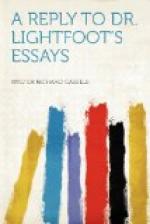Not a word of qualification or doubt is added to these extraordinary statements, for a full criticism of which I must beg the reader to be good enough to refer to Supernatural Religion, ii. pp. 41-54. Setting aside here the important question as to what the “gospel” of Basilides—to which Dr. Westcott gives the fanciful names of a “Life of Christ,” or “Philosophy of Christianity,” without a shadow of evidence—really was, it could scarcely be divined, for instance, that the statement that Basilides “admitted the historic truth of all the facts contained in the canonical gospels” rests solely upon a sentence in the work attributed to Hippolytus, to the effect that, after his generation, all things regarding the Saviour—according to the followers of Basilides—occurred in the same way as they are written in the Gospels. Again, it could scarcely be supposed by an ordinary reader that the assertion that Basilides used the “canonical gospels”—there certainly were no “canonical” gospels in his day—“as Scripture,” that his testimony to our ‘acknowledged’ books is comprehensive and clear, and that “in the few pages of his writings which remain there are certain references” to those gospels, which show “his method of quotation,” is not based upon any direct extracts from his writings, but solely upon passages in an epitome by Hippolytus of the views of the school of Basilides, not ascribed directly to Basilides himself, but introduced by a mere indefinite [Greek: phesi]. [17:2] Why, I might enquire in the vein of Dr. Lightfoot, is not a syllable said of all this, or of the fact, which completes the separation of these passages from Basilides, that the Gnosticism described by Hippolytus is not that of Basilides, but clearly of a later type; and that writers of that period, and notably Hippolytus himself, were in the habit of putting, as it might seem, by the use of an indefinite “he says,” sentiments into the mouth of the founder of a sect which were only expressed by his later followers? As Dr. Lightfoot evidently highly values the testimony of Luthardt, I will quote the words of that staunch apologist to show that, in this, I do not merely represent




